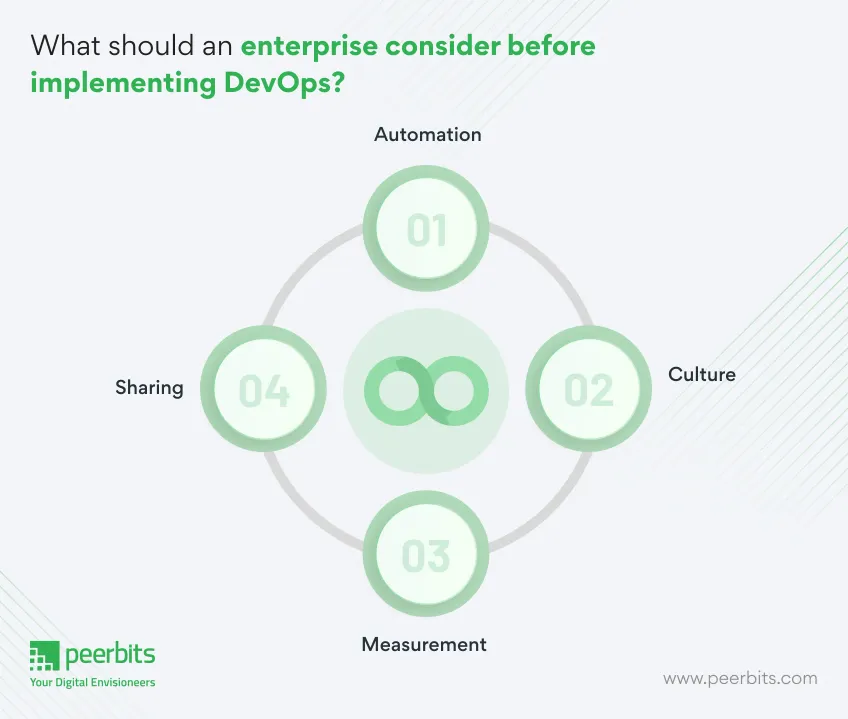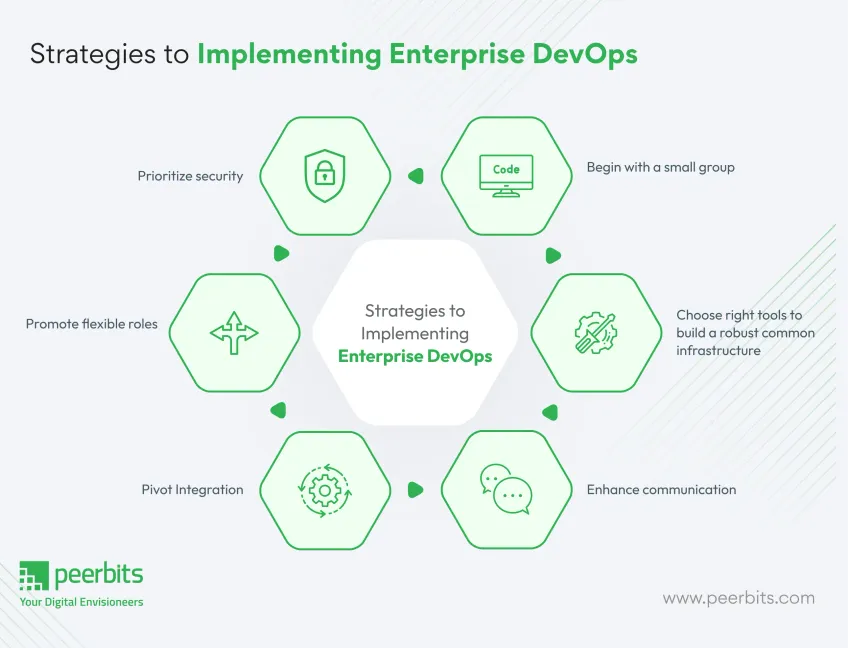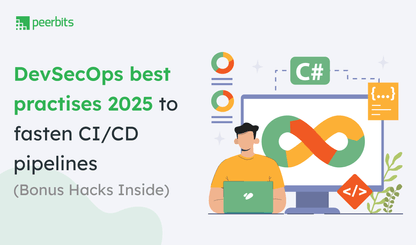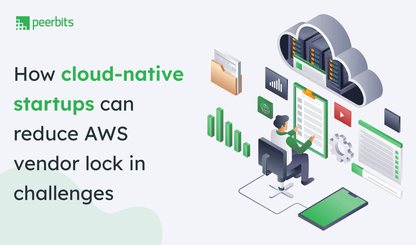Enhancing the productivity of enterprise operations and software development teams requires integrating DevOps solutions. Whether your team follows Agile practices or lacks a formal project management system, DevOps ensures streamlined workflows and improved efficiency.
According to Markets and Markets, the DevOps market is projected to grow at a CAGR of 19.7% globally by 2028. This reflects the rising demand for DevOps strategies across industries.
DevOps implementation services support monitoring and maintaining systems that run the software. While developers work on new features and bug fixes, DevOps solutions operate as a continuous and unified process.
DevOps for enterprise especially aims to improve cooperation between development and operations by ensuring lesser waste of IT resources and faster product delivery cycles. It should come as no surprise that DevOps implementation is on the rise in both big and small enterprises.
Although most resources discuss the benefits of DevOps, define CI/CD, recommend DevOps tools, and share DevOps principles and best practices, few discuss how to perform a DevOps implementation from scratch.
This blog will help you navigate the best ways to implement DevOps for enterprise.
What should an enterprise consider before implementing DevOps?
It is best to approach DevOps in a systematic manner that helps utilise the ability of a DevOps team to detect and fix possible issues rapidly. As a result, a DevOps team may have a significant impact on all levels of an organization. Here are four significant insights an enterprise shouldn’t avoid before implementing DevOps.

1. Automation
Enterprise DevOps automation help make business operations more efficient, especially if a DevOps team automates enterprise services. While some of your business’s services may be too complicated or costly to automate, others may not be.
A team of DevOps engineers will look for alternatives if the investments of automating enterprise services exceed the advantages.
2. Culture
The key to implementing DevOps for enterprises is to have a DevOps team that has the power to change the culture of an entire company. You can always implement DevOps' best practices to improve operational efficiency across different business areas.
The success of an organization’s corporate culture may be directly attributed to how you implement DevOps for the enterprise.
3. Measurement
Robust business functions need a substantially greater degree of automated business KPIs accessible on demand. They also have marginally lowed fewer manual system metrics collected.
Nonetheless, DevOps providers must manually gather some indicators and monitor them consistently. Enterprise revenue, renewal rates, client acquisition expenses, overhead costs, and variable cost percentages are just a few of the KPIs that enterprises need to consider.
4. Sharing
Highly advanced businesses move from being primarily done inside particular teams to being done across all company divisions. You can choose a DevOps consulting service that helps share automation and deployment techniques with other departments inside an organization. You can utilize sharing options to streamline and standardize your daily activities.
Components of DevOps
- Implementing DevOps for enterprise environments requires an understanding of its core components, which work together to drive operational efficiency and collaboration.
- Continuous Integration (CI) and Continuous Delivery (CD) are the backbone and ensure that code changes are tested and deployed rapidly without compromising quality.
- Infrastructure as Code (IaC) lets enterprises automate and manage infrastructure at scale, promoting consistency and reducing manual errors.
- Real-time monitoring and logging provide critical insights into system performance, helping with swift issue resolution.
- These components collectively simplify complex workflows and support enterprises in achieving a seamless DevOps for business.
Challenges in DevOps adoption
Any change within the organization is bound to face some resistance. It is best to confront enterprise DevOps challenges due to various problems that may arise. You will need the right patience, support, and dedication to implement DevOps for the enterprise.
If your business is considering implementing DevOps or looking for new methods to strengthen your strategy, be prepared to face the following challenges.
1. Lack of adequate governance
DevOps features, such as “automation,” help reduce time-to-market, but this is only one of the many features you should consider. When employees in your organization may start using it without any kind of regulation, this is where the problem begins.
Consequently, the final product may get terrible reviews or be of poor quality, ultimately leading to project failure.
2. Adopting tools without DevOps
Top enterprises start using DevOps technologies without first attempting to grasp the idea. They put it into practice in their context. For example, you may study every configuration management technology to find out how it can be integrated effectively into your project.
An immediate implementation may not necessarily provide enterprise DevOps transformation in certain cases.
3. Lack of monitoring and logging
DevOps offers a slew of advantages, which include monitoring and logging. You can pivot DevOps resources to log and monitor systems, including DevOps.
4. Moving from legacy infrastructure to microservices
Organizations use infrastructure as code and microservices to and sharpen innovation that helps eliminate stability challenges. Ensuring that new and old systems co-exist better, your business must regularly upgrade its hardware and software infrastructures to keep up with the newest trends.

DevOps best practices you must follow
Remember, DevOps need not have a defined structure outlining methods that employees might follow to achieve their intended objectives. It may be difficult for employees who blindly follow the rules and standards to adopt them.
This way, DevOps transformation need not rely on structured strategy, allowing teams to make their own decisions and provide greater room for creativity.
1. Team-wise tools implementation
Your deployment process should involve workshops for each team and apply tools meaningfully. DevOps teams can handle all the first-line assistance that often follows the completion of a workshop occasionally.
Just come up with a goal for implementing DevOps for enterprise, introduce them to the new tool, and then complete the necessary post-training feedback.
2. Implement automation
Enterprise DevOps implementation would need businesses to merge into the main repository more often when using continuous integration and delivery (CI/CD). This will eliminate the need for human code reviews by automating everything from bulk commits to regular commits.
Automated testing is a vital part of effective DevOps methods, in addition to CI/CD. End-to-end, unit, integration, and performance testing are all examples of automated testing.
3. Serverless approach
Serverless infrastructure is ideal for cohesive DevOps implementation. Serverless providers take more operations and administration chores care of with the help of cloud-native applications.
Here, developers and operations teams for DevOps for enterprise transformation can focus on designing and delivering applications rather than infrastructure maintenance.
Businesses can leverage DevOps consulting services using a range of serverless solutions like Google Cloud Platform, AWS Lambda, and Azure functions to execute application code on serverless infrastructures.
Enterprise DevOps methodology
To implement DevOps for enterprises effectively, a clear strategy is essential. Enterprise DevOps transformation starts by breaking down silos between development, operations, and security teams, promoting a culture of collaboration and shared responsibility.
Automated testing and CI/CD pipelines simplify deployments and eliminate bottlenecks. Containerization technologies like Docker and Kubernetes offer scalable application management.
By integrating security into DevOps practices, businesses can meet compliance requirements and protect sensitive data.
With a well-planned DevOps strategy, enterprises can continuously adjust to market demands and enhance their workflows.
Peerbits provides dedicated enterprise DevOps services to help organizations navigate this transformation with ease.
Strategies to implementing enterprise DevOps
Implementing DevOps for the enterprise involves adopting agile methodologies to thrive. But, many businesses fail to get the advantages since they must fight with outdated strategies that no longer serve the purpose. These organizations come with the right approach for transformative DevOps development.

1. Begin with a small group
For the first few months of implementing DevOps in your enterprise, it is better to start with a smaller group to see how it goes. As soon as the findings are acceptable to the small group, you may apply the same procedure to more groups and repeatedly measure the output.
2. Choose right tools to build a robust common infrastructure
Picking up the right set of tools is necessary to define the success of your DevOps implementation process. Such a roadmap to implement enterprise DevOps will consider adequate integrations.
Here, you need to choose tools compatible with your specific IT infrastructure. You can design a strong infrastructure with customized processes and access restrictions that enhance utilization and deliver seamless performance when you choose the right tools.
3. Enhance communication
Enterprise DevOps solutions can result if your communication and cooperation are at their best. Communication and collaboration solutions help bridge the gap between development and management teams.
Find out how operations teams react in real-time and convey any underlying issues, making it easier for development teams to update the software and promptly distribute it to end-users.
4. Pivot Integration
Legacy software-dependent teams companies should integrate processes and software tools as feasible to coordinate activities across teams. Such a cohesive way of implementing DevOps for enterprises will aid in the availability of data to the employees.
5. Promote flexible roles
Enterprise DevOps transformation requires everyone in the team — engineers, ITOps, and other resources to have the knowledge and communication skills necessary to work together across functional boundaries. Here, they need to be prepared to play multiple roles during DevOps implementation.
6. Prioritize security
The faced software development environments will demand agile teams to follow the security protocols. This is true when communication is restricted and everyone is on a tight schedule. Implementing DevOps for enterprise will have everyone in the team working with apps, containers, and microservices that all use the same set of passwords and access tokens.
Your enterprise DevOps transformation may face security bottlenecks if you are bad at managing asset and data security. In such cases, hackers can interrupt operations and steal important information that may jeopardize digital transformation.
Read more: Role of DevOps in digital transformation
Benefits of implementing DevOps
A successful DevOps implementation requires a genuine desire for the solution. DevOps adoption is more than simply keeping up with the latest trend. Implementing a strategy to improve the software development process and increase revenue is necessary.
Have your DevOps development company get a head start on huge projects by building many prototypes. DevOps implementation plan may be applied to a specific module to assess how it works. Then the whole process can be automated using technologies like Teamcity, Azure DevOps, Jenkins, and so on.
1. Building collaboration
Use your resources wisely as they make up a critical factor for successful DevOps deployment. You can also hire DevOps experts that are well-versed in the most current and necessary tools to work together with other teams and eliminate organizational silos.
Implement DevOps best practices as teams from various backgrounds learn to collaborate and cooperate within the organization. As a result, the teams’ ability to access data and information increases, as does their ability to communicate effectively. Consequently, it speeds up the development and deployment process without interruptions.
2. Containerizing
Docker is a solution that may help with this issue, for example, when a piece of software is moved from the development environment to a testing environment and subsequently to production.
Everything you need to execute an applications, like libraries, configuration files, and dependencies, is contained in a container. The software’s containerized components are isolated from the rest of the IT infrastructure, which helps ensure reliability in any environment.
3. CI/ CD pipeline
There are several advantages to the continuous deployment, integration, and delivery process. The administration and packaging of configuration and code as a part of the DevOps implementation process includes code integration, identifying defects, and improving product quality.
Continuous delivery is a follow-on to CI, verifying that a release is ready to go. A primary goal of Continuous Deployment (CD) is to help code move from one environment to another through automated means. Another important feature, which is included in metrics, is continuous monitoring throughout the pipeline.
4. Automate Infrastructure delivery
Configuration and provisioning of systems should be automated. As a result, the possibility of a developer relying overtly on a company’s operations is reduced.
This helps DevOps implementation teams provide solutions that match the production environments of both development and quality assurance teams. Self-service is facilitated by an automated infrastructure, which many business units may use. As a result, it may lead to higher productivity and employee happiness for businesses.
5. Focus on feedback
Improve the efficiency of system installation and provisioning as feedback takes the front seat in your DevOps implementation. There is less risk that a developer’s advancement may outpace a company’s operations.
Getting regular feedback will help DevOps teams to create solutions that match the production environments of the development and quality assurance teams.
A completely automated infrastructure encourages self-service in many business units. As a result, productivity and employee satisfaction may rise.
6. QA alignment with development
Automated testing is an essential part of DevOps to speed up the delivery process. Not all testing must be automated, though. If you’re doing exploratory, usability or security tests, manual testing should continue to be employed instead of automated testing.
Some functional testing may remain human if it takes too long and is too difficult to create automated tests.
To avoid issues once the product has been released to the public, quality testing and development happen simultaneously.
While the software is still under development, experts recommend performing automated tests 1-2 times a day as one of the best DevOps practices.
Whenever the team discovers a development team can develop a new build that is tested and then published for general use.
7. Ensure longer commitment
Investments in time and resources are necessary for an efficient DevOps deployment. When there are publicly accessible KPIs and indicators, it may still take some time to achieve and assess a high level of adoption.
An organization’s DevOps development structure must be rebuilt to use DevOps approaches properly. Customers should expect faster and better software updates if this new execution approach is used correctly.
8. Improved coordination
You may plummet the number of unnecessary manual jobs by using these strategies properly. In addition, it will boost workers’ output. Your team’s performance will improve due to less work that isn’t essential.
9. Enhanced operational efficiency
Drive employee productivity with DevOps implementation once you ensure following proper procedures. This will lead to lower expenses and more automation. The processing time will be reduced if the teams work together in harmony.
10. Higher Revenue
An organization’s operational methods have been shown to lead to more frequent software releases, leading to an increase in revenue. Such an enterprise DevOps transformation leads to increased KPIs, fewer expenditures, and stability, streamlined along with the optimized operating process.
11. Improved customer experiences
With enterprise DevOps solutions, businesses may increase their deployment frequency by 200x, reduce recovery times by 24x, and reduce change failure rates by 3x, among other benefits.
It is feasible to assure the dependability and stability of an application after each new release if the delivery pipeline is automated. Organizations benefit from increased customer satisfaction when their apps work smoothly in production.
12. Early defect detection
DevOps implementation creates a culture of knowledge sharing across the teams because of its collaborative nature. The total build quality is enhanced by automated, ongoing monitoring and testing of the code. Defects may be caught early and fixed quickly when teams can communicate their comments between themselves.
Achieve top enterprise DevOps With Peerbits
Implementing DevOps strategy at an enterprise level can be challenging, but with the right partner, it becomes a growth-driving initiative. Peerbits offers complete enterprise DevOps solutions that cater to the unique needs of large-scale businesses.
Our expertise covers automation, CI/CD pipeline implementation, and advanced monitoring systems, helping businesses accelerate their digital transformation journey.
Peerbits’ enterprise DevOps services help companies reduce deployment times, minimize downtime, and improve overall performance.
From initiating enterprise DevOps transformation to optimizing existing processes, Peerbits provides solutions designed to meet business objectives and drive lasting success.
Conclusion
When done with proper planning, implementing DevOps becomes straightforward.
The process is simplified with key elements such as release management, architecture as code, continuous testing, orchestration, and feedback loops. Our templated method makes implementation more efficient and effective. DevOps implementation is a crucial aspect that may be achieved using a template method to speed up your company’s development.
Implementing DevOps in the correct manner with adequate preparation becomes a simple effort. Incorporating the four elements of DevOps, such as release management, infrastructure as code, continuous testing, orchestration, and feedback loops have never been easier than it is today thanks to our templated method.
DevOps is a critical aspect in accelerating your business’s development, and when implemented using a template approach, it may provide a broad range of advantages.

FAQ
DevOps teams streamline processes, optimize workflows, and provide solutions to large-scale business needs. Ensures smooth deployment and maintenance.
DevOps teams analyze workflows, set up CI/CD pipelines, and integrate automation tools that improve collaboration and efficiency within an enterprise environment.
Teams assess existing infrastructure, plan for improvements, and implement strategies that improve scalability, security, and workflow optimization to meet business goals.
DevOps teams implement solutions that comply with industry standards such as ISO, GDPR, and PCI DSS, ensuring secure and compliant systems for enterprises.
DevOps brings cost-effective scalability, automation, and specialized tools, making it easier to implement robust solutions that improve system performance and business outcomes.
DevOps teams use Agile, CI/CD, and Infrastructure as Code (IaC) practices to ensure smooth deployment, continuous integration, and automated testing for enterprise-level systems.








